Artist Wendy Nanan explores post-colonialism, identity through dolls
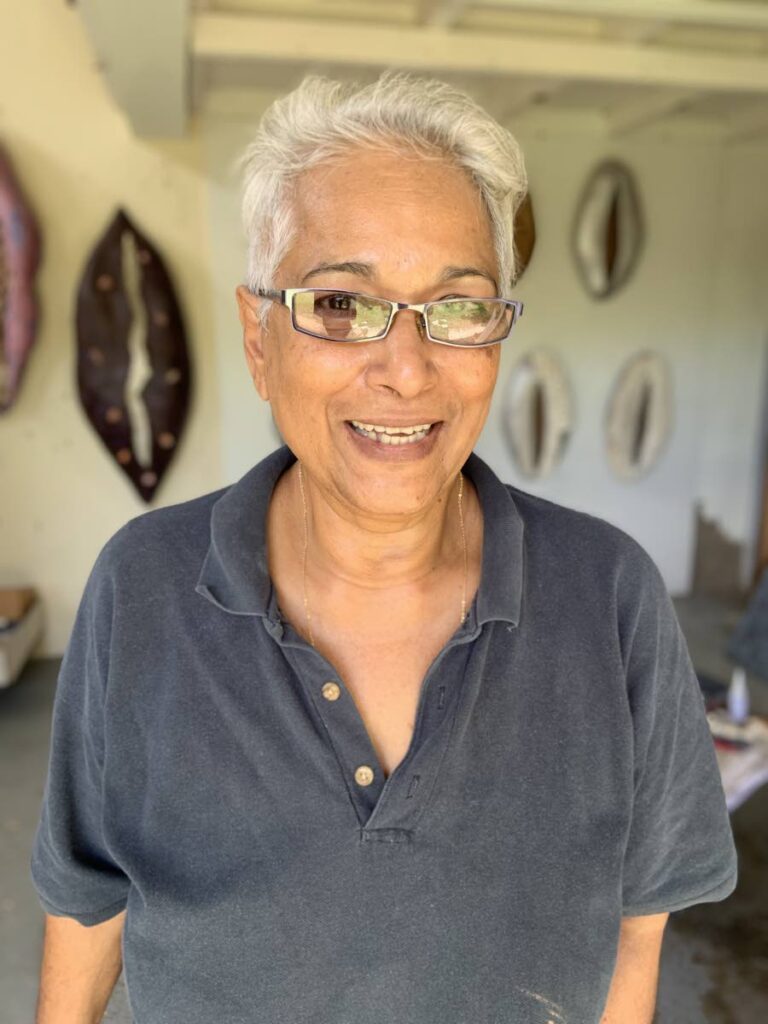
DURING the covid19 pandemic, artist Wendy Nanan was going through her belongings and came upon her collection of West Indian dolls.
They inspired her to create an exhibition that explores various themes including race, commercialisation, cultural identity, and sexual harassment.
Nanan spoke about her exhibition West Indian Dolls, a Portrayal of Blackness with Newsday at the Medulla Art Gallery, Port of Spain.
The dolls were acquired during her travels with her father throughout the Caribbean in the 1990s in places such as Caracas, Cuba, Grenada, Santo Domingo and St Vincent. She said they were very expensive and sometimes her father would indulge her and pay for them.
In her statement about the exhibition, she explained that she was "first intrigued by the political and social implications of how we were representing ourselves in a modern, post-colonial society."
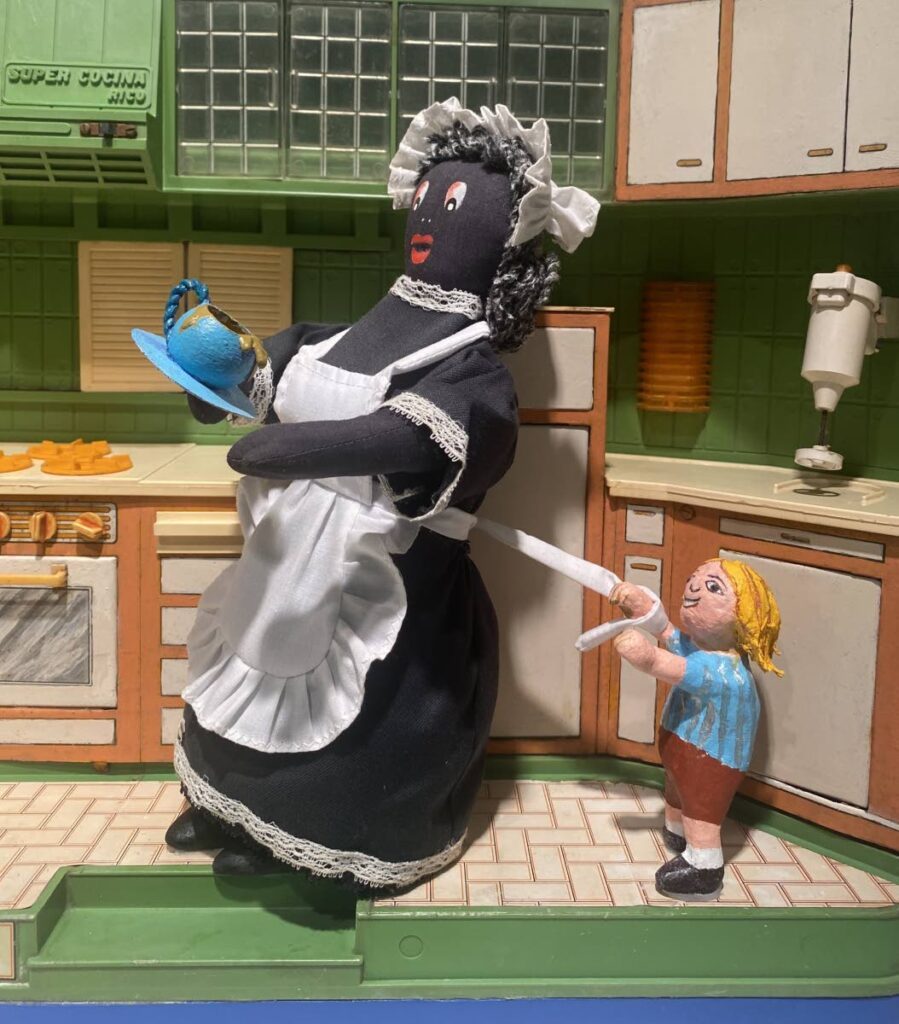
The exhibition features dolls placed in eight dioramas.
One standout piece, Let Me Take You to the Mountain Tops, features three dolls. Nanan recalled two of the dolls were bought at a jumble sale at Greyfriars Church, Frederick Street, Port of Spain, (demolished in 2014). She also recalled she had to "fight" a little girl for them.
"I was looking at it and she came down and was looking at it. And I know I wanted it because it was so beautifully done."
There were three dolls in the sale, and she bought two and let the little girl have the third.
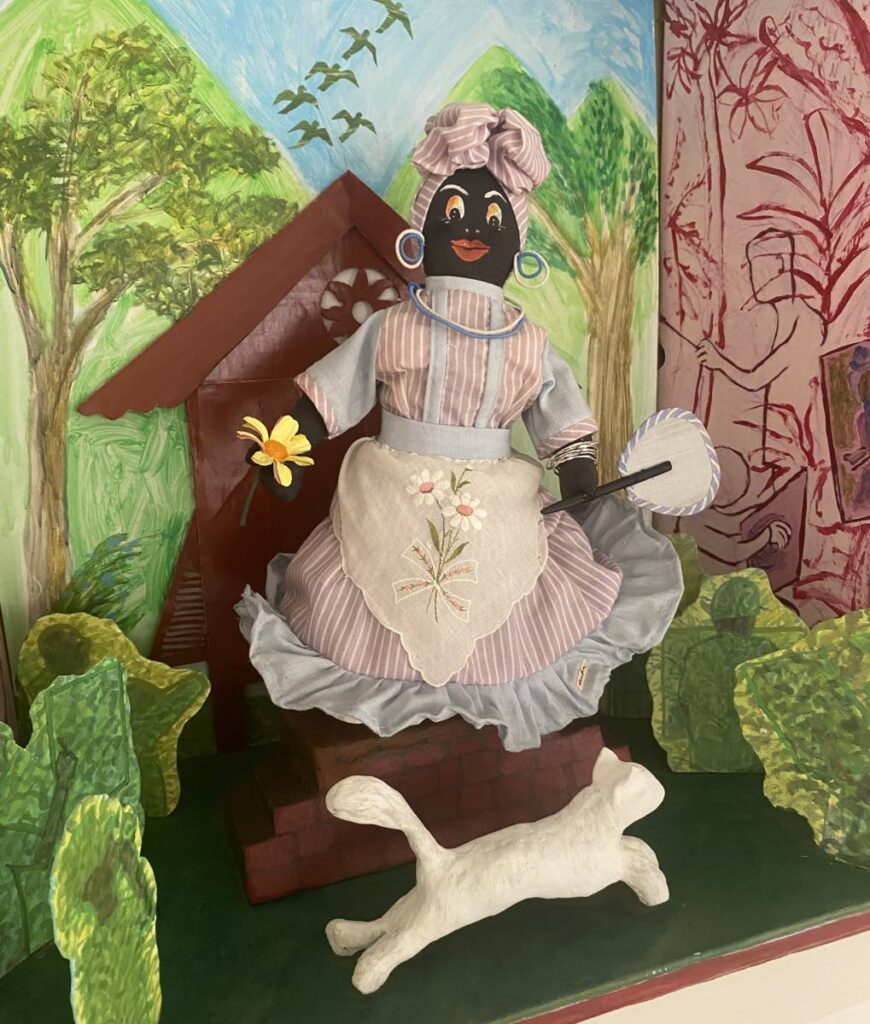
In the piece, the two dolls flank a third, from Santo Domingo. She and her father went into a shop and Nanan was on the lookout for earrings made of lorimar (a blue silicate found only in the Dominican Republic).
"I saw this thing and I was so amazed, because this was the first doll I had ever seen...with an Afrocentric modern appearance to her. You see the natty hair, the full afro hair."
For the piece she changed the doll's costume to one with African colours, Jamaican beads and a cape.
"Because she is like the Caped Crusader. And she is pulling these two dolls with her, and she is saying, ‘Come...this is our time to come out of colonial attitudes.’"
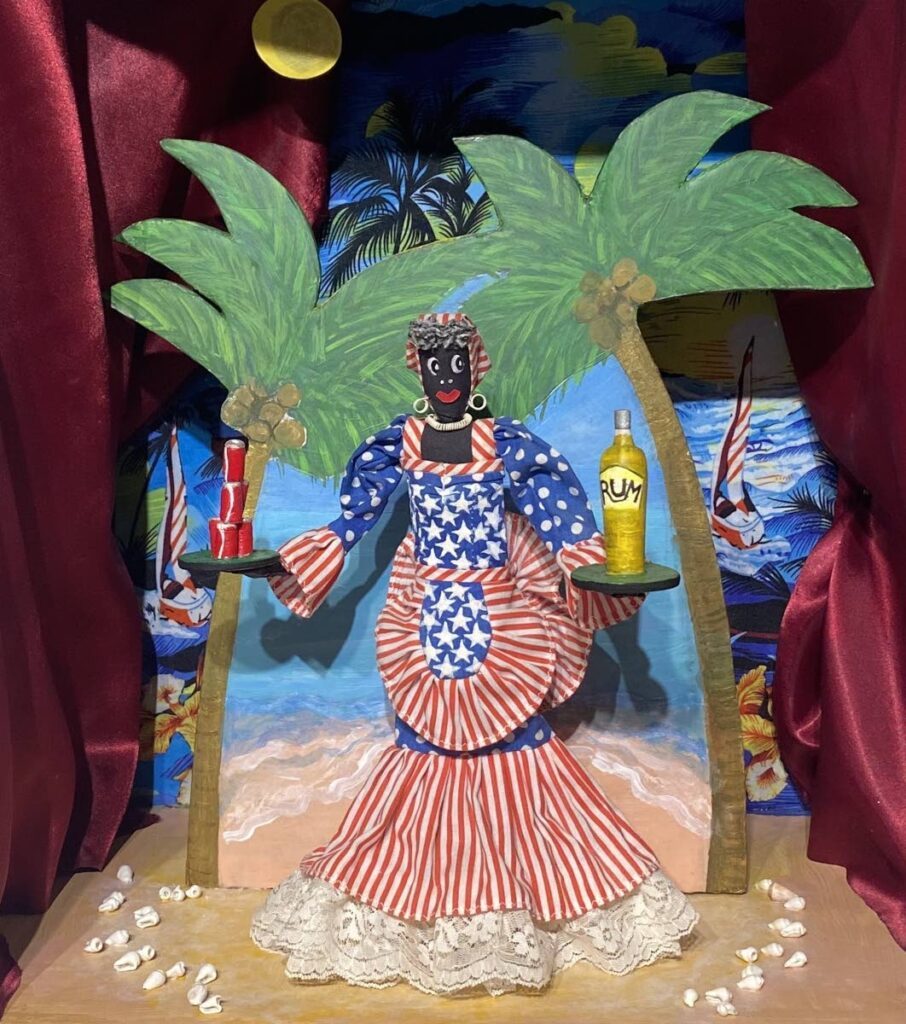
The other two dolls are in the costumes of colonial/post colonial female servants, but the middle one is a modern costume. And the mountain she is calling them up to is a reference to American civil rights leader Martin Luther King Jr and his famous "I have a dream" speech. Through the mountains Nanan visually charts a journey from slavery to the Black Lives Matter campaign up to a plane that says, "You have come a long way."
Intricate work
She described another piece, Caribbean Madonna, as an autobiography, as it itemises all the bodies of work she has done, such as her exhibition of books, baby Krishnas and the night skies, and her last exhibition of bananas and shells.
"Maybe I am boldfaced, I'm positioning myself as a Caribbean Madonna."
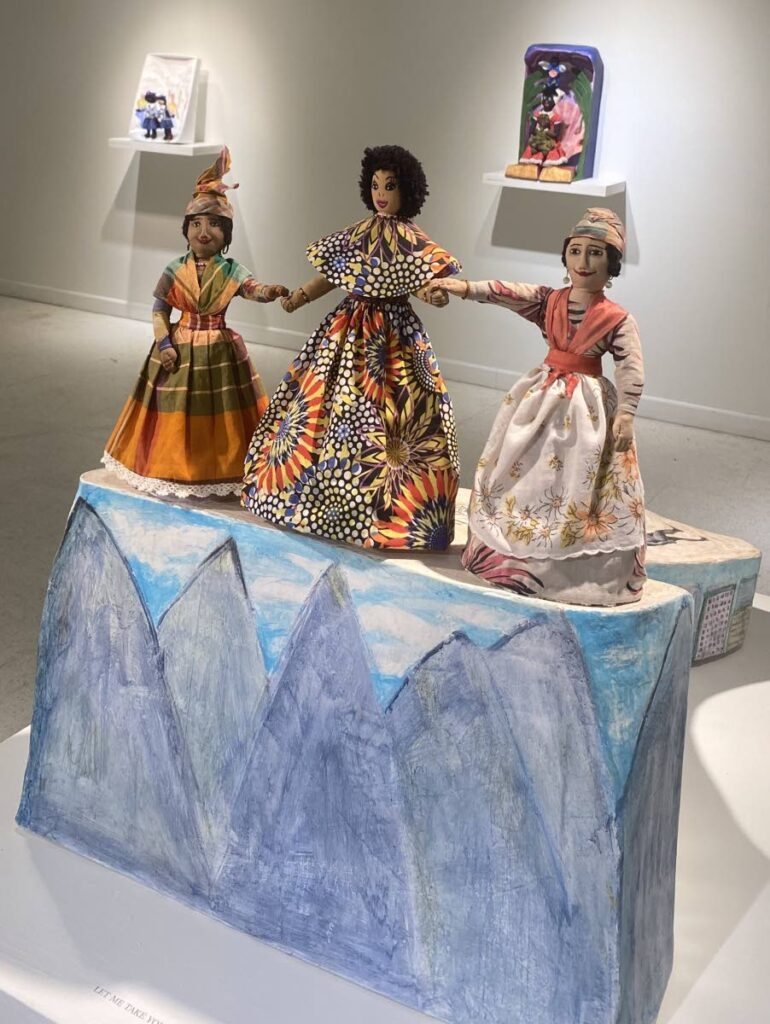
In the piece, a Sambo doll ("sambo" is an archaic and demeaning term for a black person) holds a baby doll in keeping with the Madonna theme.
In her artists's statement, she said she collected the dolls because they were "beautifully and intricately handmade, showing the signatures of their creators, much like fingerprints on ancient Sumerian pottery."
She added: "I imagined the women making the dolls, hoping for sales, having to pander to the ingrained racist and sexist views of the buyers. More concerned with everyday survival than perpetuating these prejudices."
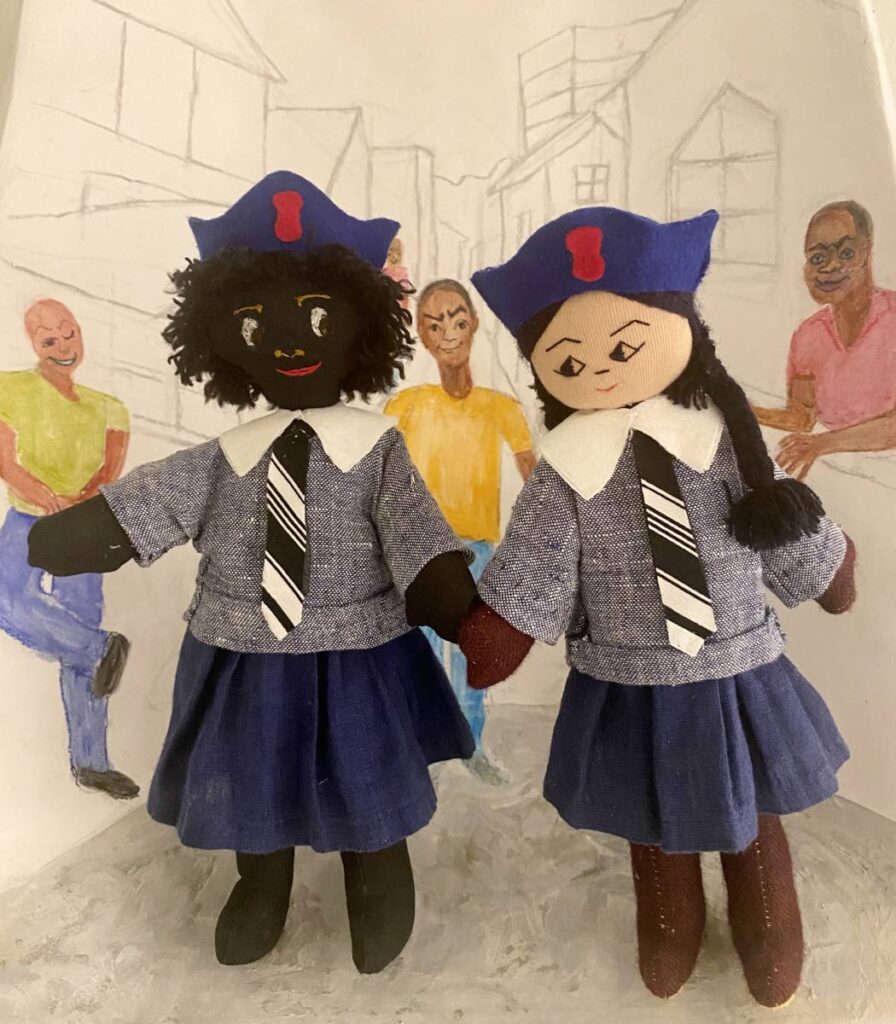
She sewed school uniforms for the two dolls featured in the piece, Did You Buy the Pepper-Spray Yet? to replace their native costumes.
"And that must be the most clumsily sewn thing in the whole exhibition. Because it is very difficult to handle with my hands and you have to be threading the needle 30 times before you get it through the eye."
In Did You Get the Pepper-Spray Yet? the dolls, dressed as schoolgirls, are in a diorama with a group of men calling out to them, including one delivering the titular line. Nanan explained the two girls are walking on the street, feel threatened and want a little protection.
"And they are looking at each other and they are kind of frightened and they are holding hands.
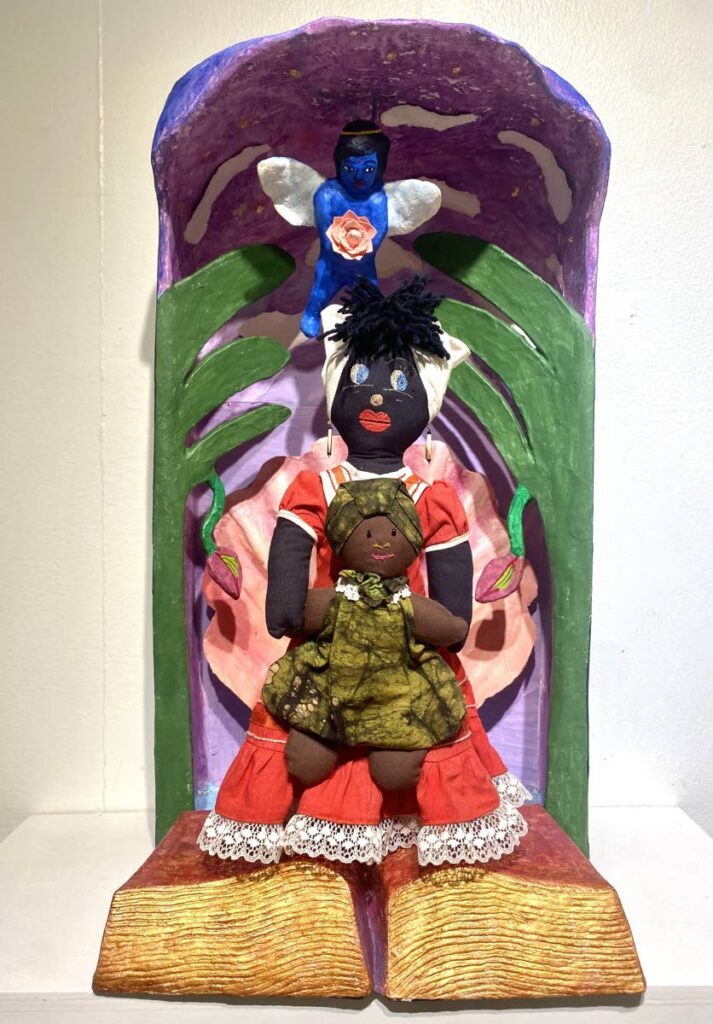
"This is something with children who are not chauffeured around after school and they have to walk the street. This is what they have to go through when they are small."
Romanticising the past
She also spoke about her piece Searching for La Belle Creole.
"You know we have a school of painters in Trinidad and Tobago who are still painting these kinds of pictures – you can see them in the shops – who do commissions. There are people who paint little old ladies with an ajoupa house behind them and usually there is a dog or a cat running in the foreground.
"It is like they are romanticising 'La Belle Creole.' They don't actually know what is going on with the lady. They don't know if she may have ten children and she is trying to find some means and ways (to get by) and her house is falling down."
In the piece, the doll representing La Belle Creole is converged on by painters disguised in the bushes and the bright red trees of the forests.
"Why don't you paint what is here and now, instead of always trying to romanticise the past which was not always fair to everyone?"
Nanan also spoke about the historical figure of Tourist Annie, who would dress in a large headtie with a basket selling souvenirs and pose in the street for tourists."
Her piece Les Marchandes in the City features three dolls dressed like colonial street vendors (marchande means "pedlar" and is of French origin) looking out of place amid a looming silver city. Nanan said the piece was meant to demonstrate that the now-modern city can no longer accommodate these ladies.
She added, however, people were still making these types of marchande dolls for sale. Nanan said it was "a very romantic idea of being West Indian," though it no longer exists.
Selling ourselves
Other pieces in the exhibition are: The Help, which features a black maid doll and a boy pulling her apron strings in the setting of a tin lithographic toy kitchen; Meanwhile, Somewhere down Pt Cumana, which features a Puerto Rican doll dressed in the US stars and stripes and serving rum and Coca-Cola on a stage; and The Land of the Photo-Op, which features different tourist-centric scenarios in Trinidad.
"If you go to a hotel and they are putting on a show for the tourists...they are going to have limbo, they are going to have steelpan. These are the things that are sold to tourists as being West Indian, not even particularly Trinidadian...(but) of ‘island people.’
"We know these things. It has come from us. From our histories. We enjoy them. But should we always be selling to other people as what we are?"
She said as a people we are not bothered by any limitation of these representations, but we just accept it and laugh at it.
Nanan wrote in her artist statement: "I recently saw a Facebook post asking for a photo-op of a coconut vendor with donkey cart. We are still painting pictures of La Belle Creole with wooden ajoupa houses in forested clearings. In my childhood, Tourist Annie walked the streets of Port of Spain, looking very out of place.
"How do we see and understand ourselves, descendants of the many mixtures of colonisers, slaves and immigrants? And how have we commercialised this history and imagery into clichés to make it marketable for consumption by outside worlds? Is this the masque of our blackness as island people?"
She expressed the hope people will come to the exhibition and was not concerned if anyone "understands anything from it.
"These are the ideas that I had. But they may come with ideas that may be even more interesting."
She said the person viewing the work does not need to know anything of what the artist thought.
"Why should an artist always stand in front of a work preaching about it? The work should exist on its own. You come and you see it and you gain from it. I would like them to think a little bit."
She also wants people to appreciate the beauty of the dolls.
Asked if the pieces were for sale, Nanan said they were and that was being worked out. She added that if anyone wanted to donate West Indian dolls to her, they can leave them at Medulla Art Gallery.
About the artist
Medulla Gallery's artist info states that Nanan, born in TT in 1955, is among the first Caribbean women artists to have a long and sustained professional practice.
She got her BFA at Wolverhampton Polytechnic, England, in 1979.
Her work is included in many public and private collections, including the National Museum.
In her practice, Nanan takes on core questions at the heart of historical and contemporary struggles about identity, culture and power in the region.
She has produced work that is historically and geographically specific to the place she inhabits, and timeless, gently provocative and persistently infused with her feminist politics. While Nanan is deeply respected by peers and critics in the Caribbean, she remains an under-attended-to artist, in part due to her determined locally-situated practice, Medulla said.
She has remained in Trinidad since completing art school in 1980, and is famously reclusive, her philosophy being that “it is more important to create the work than to seek an audience for it.”
More info
The exhibition at 37 Fitt Street, Woodbrook, Port of Spain, continues until September 29. Admission is free. The gallery hours are Monday-Friday 10 am-6 pm, Saturdays 11 am-2 pm.


Comments
"Artist Wendy Nanan explores post-colonialism, identity through dolls"